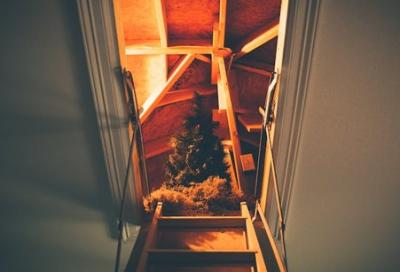Christmas is coming and the goose is getting fat…
I wonder how many of us are planning to put up our Christmas decorations this weekend. Perhaps you’re one of those people who likes to get into the festive spirit in November and your tree is already up, or are you someone who waits until the last minute? Whatever your preference, for many of us this means a trip into the attic.
Last January you boxed up your decorations and carefully rolled up the Christmas lights in the vain hope they wouldn’t get tangled. Then you popped them into your loft and promptly forgot about them until the day you needed to decorate your tree.
For many of us, the loft is little more than a bin we live under. As the old adage goes, out of sight, out of mind. When we put things into the attic it’s because we don’t want to throw them away but, at the same time, we don’t really want them in our home. After all, we never know when it ‘might’ come in handy.
This all means for 11 months of the year our lofts are completely ignored by us.
Perfect harbourage for pests
The fact most of us so rarely go into our attic means it is the ideal haven for a range of pests. It is warm, offers protection, there’s plenty of opportunity to find nesting materials and there is probably access to food nearby. Why wouldn’t a pest such as a mouse, rat, squirrel or bird choose your roof space as their home?
The sad truth is, because we so rarely go into our lofts, we might not discover a problem until it’s too late.
What damage can pests do in my attic?
It obviously depends on the pest, but a rodent (rat, mouse, squirrel) will need to gnaw to keep its teeth under control. This means damage to pipes, wooden beams and wiring, which could lead to leaks, structural problems and possible electrical fires.
Bird pests will damage the structural integrity of your roof as they fly in and out, which could enable water ingress. They will also defecate, which is not only unsightly and unsanitary but could also damage the fabric of your building. These pests might also rip up insulation or tear up stored items to make their nests.
In addition, birds can bring in secondary pests to your home. For example, nesting birds can bring in mites and carpet beetles which will stay in your house even once the bird has flown. If they are not dealt with properly, and no one wants to deal with bird waste without the right training because of the risk of disease, then they might spread to the rest of your home. Read our blog, ‘Eleven years of pigeon guano’, for information on the diseases birds can carry.
So this year, when you make your annual trip into the loft to find our Christmas decorations, why not do yourself a favour and take the time to look for signs of pests?
What to look for in your loft
Your first indication that there is a problem might actually come before you’ve entered – such as noises in the attic. If you hear a scratching sound or unusual movements, then that could be the sign of an infestation.
Once you are in the loft, you should look for:
Rodents:
- Damaged Christmas decorations, droppings or a strong smell of urine
- Gnaw marks on beams, pipes and cables
Birds:
- Structural damage to your roof
- Leaks
- Old bird nests
Insects:
- Wasps or cluster flies overwintering in hidden spaces
- Damaged textiles (moths, carpet beetles)
What can I do about the pests in my attic?
The truth is, you’ve done the most important thing by being vigilant. After that, it depends on the pest, but our advice would be to seek professional help. Attics are not easy places to work in and you need to have the right equipment to protect yourself.
On top of that, there are several things you need to consider. For example, if you find an active bird nest, it and the bird, plus any eggs, are protected under the Wildlife and Countryside Act 1981. Even if the nest is old, there is a risk of disease and secondary pests that you may fail to spot.
Finally, you need to be sure all access points are properly sealed to stop the pest from returning. This can be difficult, but a professional pest control technician is trained to know what to look for and how to deal with it. They may also spot signs of another problem that can be dealt with at the same time, thereby saving your money.
With that, let me wish you a Very Happy Christmas!
Image: Jeswin Thomas
